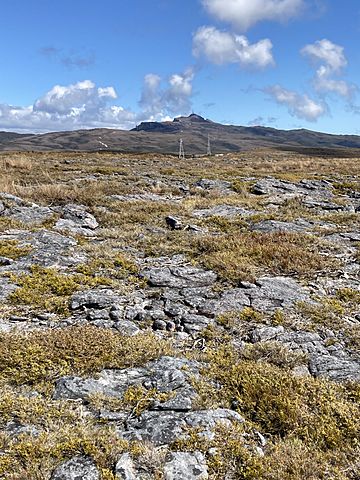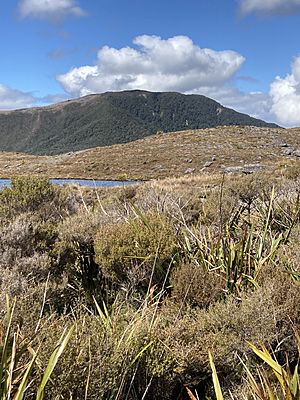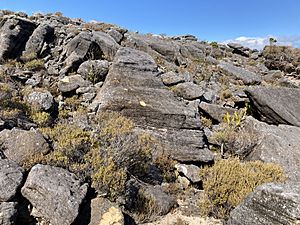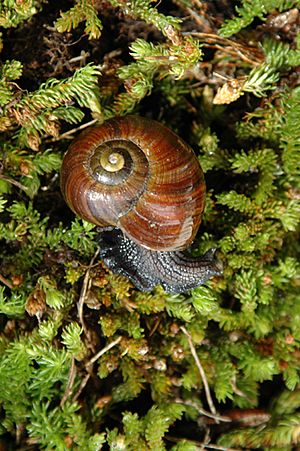Denniston Plateau facts for kids
Quick facts for kids Denniston Plateau |
|
|---|---|
| Denniston-Stockton Plateau, Mount Rochfort Plateau | |

View south to Mt Rochfort
|
|
| Highest point | |
| Naming | |
| Etymology | Named after the coal mine manager |
| Geography | |
| Location | Buller District, West Coast Region, New Zealand |
| Parent range | Papahaua Range |
The Denniston Plateau is a special place on the West Coast of New Zealand's South Island. It is a high, flat area about 18 kilometers (11 miles) long. This plateau is known for its unique plants and animals. Many of these species are found nowhere else in the world.
The Denniston Plateau also has a lot of high-quality coal. Because of this, mining towns like Denniston and Millerton were built there. Today, the Stockton Mine still operates on the plateau. However, plans for new mines have caused debates about protecting this special environment.
Contents
What is the Denniston Plateau?
The Denniston-Stockton Plateau stretches for about 18 kilometers (11 miles). It goes from Mount Rochfort in the south to Granity in the north. The plateau is about 3 to 4 kilometers (1.9 to 2.5 miles) wide. It sits between 600 and 800 meters (2,000 to 2,600 feet) above sea level.
The Waimangaroa River cuts through the plateau. This divides it into the Denniston and Stockton areas. Sometimes people use "Denniston Plateau" to talk about the whole area.
How the Plateau Was Formed
The main rock on the plateau's surface is sandstone. This rock has broken down into coarse, acidic sand. Beneath this sandstone are rich layers of high-quality bituminous coal. This coal formed from ancient swamps about 45 million years ago.
First, partly decayed plants turned into peat. Then, the ocean covered this peat, and it was pressed into coal. This happened about 37 million years ago. The plateau itself was lifted up to its current height in the last 2 million years. This lifting was part of the formation of the Southern Alps.
The soil on the plateau is very thin and often poor. It doesn't drain well and is quite acidic. Miners in Denniston even had to bring in soil for their gardens! The sandstone layer stops water from soaking in. This means the ground is often waterlogged. There are also large areas of bare rock with no soil at all.

Climate and Weather
The Denniston Plateau has a very tough climate. It gets a lot of rain and not much sunshine. It is often cold, windy, and foggy. These harsh conditions make it a challenging place for plants to grow.
Unique Plants of the Plateau
The plants on the plateau might look small and scrubby. But this is because of the harsh weather and poor soil. There are many different kinds of plants here. Some of the small, bonsai-like shrubs are actually hundreds of years old. The plateau has alpine plants that grow at unusually low heights. It also has several plants found only in this area.
In more sheltered spots, you can find low forests. These include mānuka, mountain five-finger, and southern rātā. In more exposed areas, the plants are similar to those found in pakihi swamps. These include mānuka, tangle fern, and various rushes.
The varied landscape creates many different places for plants to live. You can find bog pine, pygmy pine, and yellow silver pine. There are also several types of small, stunted Dracophyllum shrubs. Near Millerton, you can see dwarfed kāmahi trees. Both southern and northern rātā also grow here.
Many small flowers brighten the plateau. These include gentians, eyebright (Euphrasia wettsteiniana), and orchids. Some orchids are the mauve sun orchid and the swamp sun orchid. In wet areas, you might even spot carnivorous sundews (Drosera spatulata).
Special Plant Species
Some plants are especially unique to the Denniston Plateau:
- Dracophyllum townsonii is found only on the northern West Coast. D. densum grows mostly on Denniston Plateau and the nearby Paparoa Range.
- Four types of Celmisia daisies reach their southern limit here. These include mountain daisy (C. dubia) and scrub daisy (C. lateralis).
- The North Westland snow tussock (Chionochloa juncea) is found only on the Denniston-Stockton Plateau.
Animals of the Plateau
The plateau is home to many interesting animals. You might see great spotted kiwi, fernbirds, and New Zealand pipits. Other birds include weka, kea, and riflemen.
Reptiles living here include speckled skinks, coastal green geckos, and forest geckos. What makes the plateau truly special are its large, meat-eating Powelliphanta snails. Some of these snails are found only here and are at risk because of mining.
Unique Snail Species
- Powelliphanta patrickensis lives only on coalfields above 750 meters between Denniston and Mount Rochfort. It is also found in the Millerton area.
- Powelliphanta lignaria 'Millerton' was thought to be extinct. But it was rediscovered in 2005 in a small area near Millerton.
- Powelliphanta augusta lived in a small area on Mount Augustus. This area was affected by mining. In 2006, the entire known population of these snails was moved into special containers. The Department of Conservation now cares for most of them.
New Discoveries
In 2012, scientists and volunteers did a "bio-blitz" on the plateau. This means they quickly searched for and identified as many species as possible. They found several new species, including:
- A day-flying moth called Arctesthes avatar. It was named after the movie Avatar because the movie is about mining harming a natural environment.
- A cave weta, which was unofficially called the Denniston white-faced weta.
- A new beetle, another moth, a wingless wasp, and three new spiders.
Protecting the Plateau
The northern part of the plateau has been changed a lot by the large Stockton Mine. In 2011, a company called Bathurst Resources wanted to start a new mine called the Escarpment Mine Project. This mine would have been in the southern part of the plateau. It would have involved removing the surface plants and rock to get to the coal.
This plan caused a big debate. Some people wanted the jobs and money the mine would bring. Others wanted to protect the unique and delicate environment of the plateau. Environmental groups like Forest and Bird fought the mining plans in court. They also suggested creating a large nature reserve on the plateau.
In 2014, the Department of Conservation gave permission for the mine. This was in exchange for money to help protect other areas. However, the price of coal dropped a lot. Also, a major buyer for the coal closed down. Because of this, the mining project became too expensive. Bathurst suspended its operations in 2016. This meant the new mine did not go ahead, helping to protect the plateau for now.
Images for kids




